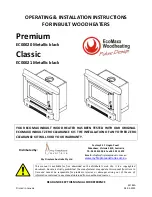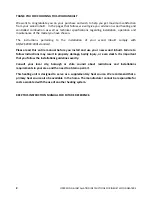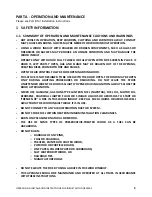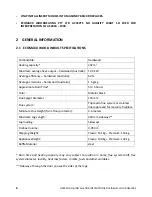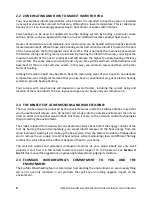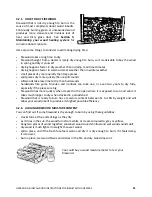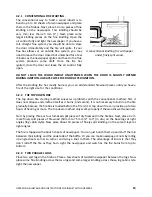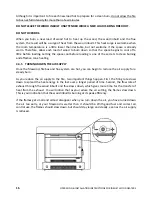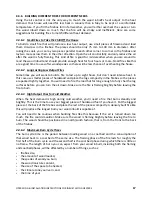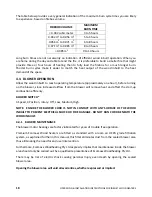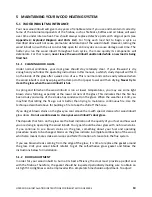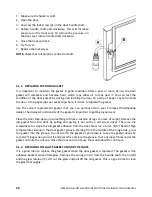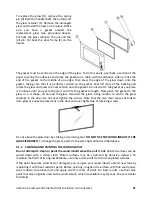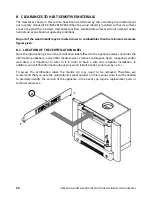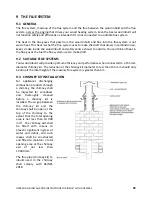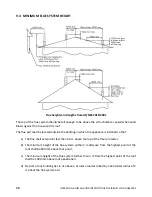
OPERATING
&
INSTALLATION
INSTRUCTIONS
FOR
INBUILT
WOOD
HEATERS
15
The
best
time
to
remove
ash
is
after
an
overnight
fire
when
the
wood
inbuilt
is
relatively
cool,
but
there
is
still
some
flue
system
draft
to
draw
the
ash
dust
into
the
wood
inbuilt
and
prevent
it
from
coming
into
the
room.
NOTE:
The
blower
should
be
turned
in
“OFF”
position
prior
to
ash
removal
to
avoid
ashes
to
be
pulled
towards
the
inbuilt
and
then
pushed
into
the
room.
After
ashes
have
been
removed
from
the
wood
inbuilt
and
placed
in
a
tightly
covered
metal
container,
they
should
be
taken
outside
immediately.
The
closed
container
of
ashes
should
be
placed
on
a
non
‐
combustible
floor
or
on
the
ground
well
away
from
all
combustible
materials
pending
final
disposal.
Ashes
normally
contain
some
live
charcoal
that
can
stay
hot
for
several
days.
If
the
ashes
are
disposed
of
by
burial
in
soil
or
otherwise
locally
dispersed,
they
should
be
retained
in
the
closed
container
until
all
cinders
have
thoroughly
cooled.
Other
waste
shall
not
be
placed
in
this
container.
NEVER
STORE
ASHES
INDOORS
OR
IN
A
NON
‐
METALIC
CONTAINER
OR
ON
A
WOODEN
DECK.
4.3.3
RAKING
CHARCOAL
Rekindle
the
fire
when
you
notice
that
the
room
temperature
has
fallen.
You
will
find
most
of
the
remaining
charcoal
at
the
back
of
the
firebox,
furthest
from
the
door.
Rake
these
coals
towards
the
door
before
loading.
There
are
two
reasons
for
this
raking
of
the
coals.
First,
it
concentrates
them
near
where
most
of
the
combustion
air
enters
the
firebox
and
where
they
can
ignite
the
new
load
quickly,
and
second,
the
charcoal
will
not
be
smothered
by
the
new
load
of
wood.
If
you
were
to
simply
spread
the
charcoal
out,
the
new
load
will
smoulder
for
a
long
time
before
igniting.
Remove
ash
first,
and
then
rake
charcoal
towards
the
front
of
the
firebox
before
loading
so
that
it
will
ignite
the
new
load.
4.3.4
FIRING
EACH
NEW
LOAD
HOT
Place
the
new
load
of
wood
on
and
behind
the
charcoal
and
not
too
close
to
the
glass.
Close
the
door
and
open
the
air
control
fully.
Leave
the
air
control
fully
open
until
the
firebox
is
full
of
flames,
the
wood
has
charred
to
black
and
its
edges
are
glowing
red.
Firing
each
load
of
wood
hot
accomplishes
a
few
things:
•
drives
the
surface
moisture
from
the
wood,
•
creates
a
layer
of
char
on
the
wood,
which
slows
down
its
release
of
smoke,
•
heats
the
firebox
components
so
they
reflect
heat
back
to
the
fire,
and
•
heats
the
flue
system
so
it
can
produce
strong,
steady
draft
for
the
rest
of
the
cycle.

